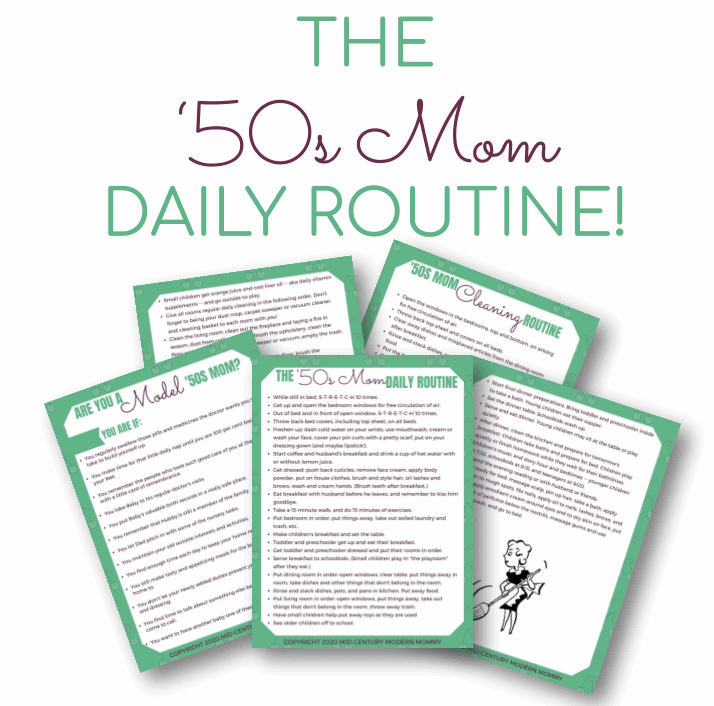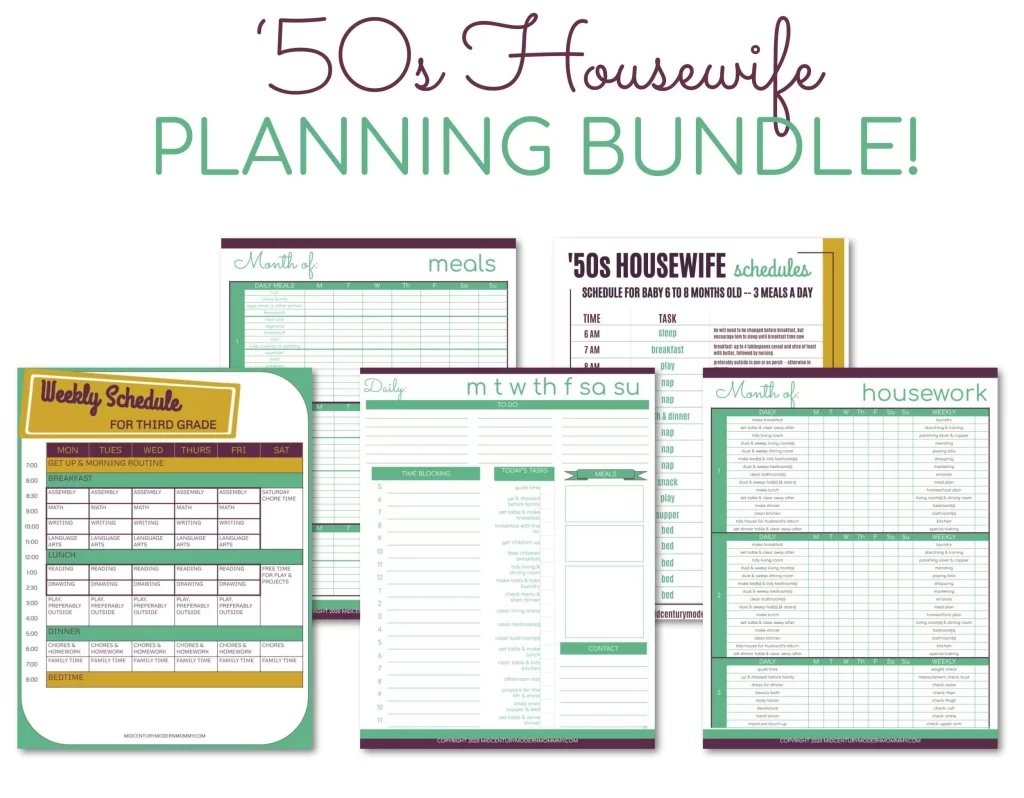
The mid-century housewife, full of pride in her beautiful home, tried to always have a company-ready, beautiful, clean house. She took pride in keeping the house neat, clean, and fresh every day. What if her husband wanted to bring a friend home after work? After all, a wife who was trying to help her husband be successful was always ready to entertain a VIP or his boss at a moment’s notice. (And do it successfully and graciously!)

Get Our Mid-Century Mom Daily Routine FREE!
7 Things a 1950s Housewife Did Every Day
This post contains affiliate links. If you click a link and make a purchase, I may receive, at no additional cost to you, a small commission. Find out more on my Disclosures page, and thank you so much for your support!
My husband isn’t climbing the corporate ladder, but he did grow up with a mother who loves housework. Yes, my mother-in-law loves to clean, and her house is always clean, and even as a single mom, she raised her kids in a clean house. Sigh. I, on the other hand, did not learn to clean when I was a kid. I didn’t even have assigned chores. And I started marriage as a 21-year-old who COULD NOT KEEP A SINGLE THING CLEAN!
This, clearly, is not a recipe for marital happiness. And so, I took it upon myself to become a better housekeeper. (In the interest of full disclosure, this is always a work-in-progress.) Now, the 10 of us (plus 4 rescue cats and a dog) live in a three-bedroom cottage. If it doesn’t stay clean, then it goes to CHAOS really fast. Over the years, I have gleaned the most important things that I need to do each day so that my husband doesn’t go insane, and I can feel house-proud, too. When I do these 7 things every day to keep house, our home runs smoothly.
Make The Bed
I first learned this from Peggy Jones and Pam Young and their Sidetracked Home Executives (affiliate link) books. I found out later that it is a component of every American housekeeping plan. There are all sorts of cultural reasons for this, but I really don’t think that anyone came here for an extended dissertation on the cultural and historical aspects of bed-making in America. My reasons for making the bed a pillar of my housekeeping (see what I did there?) are that my marriage is the foundation of my family, and the heart of my marriage is the marriage-bed. (TMI? Sorry.)
By making my bed, I remind myself to take my marriage seriously, and I pray for my husband and my marriage while I make the bed. I also use making the bed as a base for habit stacking. Habit stacking is taking a set of smaller habits with something in common, and creating a trigger that reminds you to do the whole set. I use keystone habits as my triggers. Making my bed triggers a whole stack of habits. I didn’t add them all at once, though. I added them one small habit at a time, once I had my keystone habit in place.
Once I make my bed in the morning, I clear all the surfaces. Every single one. I dust, sweep, and take out the laundry and trash. Then I close the windows and curtains and leave the bedroom cool and dark for the remainder of the day. This habit stack keeps our room fairly clean, helps my husband find his things easily, and reminds me to pray for my husband.

Clean the Kitchen After Every Meal
I don’t have a dishwasher, so all the dishes for 10 people need to be washed, dried and put away after every meal. My children (right now, the 13yo, the 11 yo, and the 9 yo) rotate helping with this. The order of work is clear the table, put the food away, scrape-rinse-stack the dishes, and swipe-and-sweep the dining room (wipe the tables and chairs and sweep the floor). Then fill the sink, wash-dry-put-away dishes, pots, and pans, wipe the counters and stove, clean out the sink, and sweep. Once a day, the trash gets taken out.
I usually supervise whichever two are cleaning the kitchen (because boys will water-fight whenever they can), and while I am supervising, I can do prep work. I like to use mise-en-place (a holdover from training as a pastry chef), so I prep veggies or meat, make pantry staples, appetizers or desserts, or bake bread.
Teaching children to work is best accomplished by working alongside them. If you set the example of work, and make yourself available for advice and companionship, it is quite easy to teach children to work. I require my children to help with chores starting at age 1 when I begin by having them begin with simple requests. By the time they are 6, they are capable of helping in the kitchen. Our rule is that you can’t learn to bake cookies until you can clean the whole kitchen, and it is very motivating!
Dust and Sweep
I love Marie Kondo’s books. I adore minimalism. But nine people in a cottage, homeschooling, homesteading, and working at home will never look minimalist without this habit. Why? Because dusting and sweeping require you to clear off every surface and pick up the floor. So, 3 times a day, I grab a dust rag and broom and make my house company-ready!
I start by wiping everything off the surfaces into a laundry basket. Every child who can walk gets stuff out of the basket and puts it where it belongs. If they don’t know where it goes or it doesn’t have a place, they leave it in the basket. After every surface is dusted, I grab the broom. I sweep everything on the floor into a dust pile. The kids put stuff away again and then whatever is left I put in the basket or sweep up with the dust and throw away. Then I take ten minutes to deal with the stuff in the basket. I get rid of as much of it as I can (regular decluttering!) and put away the must-haves. And I do this for every room, including bathrooms and the kitchen.
Follow a Weekly Plan
When I was little I wanted to be Laura Ingalls Wilder. I devoured Little House in the Big Woods over and over. I even went through a phase where I refused to wear anything except old-fashioned dresses and petticoats, set up a washstand with a pitcher and basin in my bedroom, and tried to learn patchwork. My favorite part, though, was the day-of-the-week for each kind of work. (I even tried to make everyone at my house follow one . . . my poor mother!) Other than the food, nothing captured my imagination as much as the idea of having a poem that told you what to do each day.
Vintage housekeeping books also recommend a weekly plan. They usually replace churning on Thursday with marketing, but everything else is pretty much the same. Even modern housekeeping books don’t update it much beyond leaving off ironing on Tuesday and replacing mending on Wednesday. My current weekly plan is essentially the same as Ma Ingalls:
Wash on Monday, Iron on Tuesday, Mend on Wednesday, Market on Thursday, Clean on Friday, Bake on Saturday, Rest on Sunday.
If I stick to this list, then I can keep up with the laundry, and I don’t spend too much money when I only shop once a week. Following a weekly plan also fits all those adorable vintage day-of-the-week-chores dish towels (affiliate link) for my kitchen!
Make Time to Be Pretty
This is so important! I will freely admit that sometimes it is much easier not to get dressed. (Especially when all 8 kids get stomach flu. On Christmas. Or is that just me?) But a vintage housewife learned early to never let her bridal freshness fade! No excuses!
Seriously, though, I do try to follow the recommendations of some of my favorite vintage advice books. All of them advocate the importance of paying attention and maintaining your looks after marriage, not just when you’re single. French women know this too, by the way. Bringing Up Bebe (affiliate link) (a hilarious book about an American raising her children as an ex-pat in France) talks about how French women refuse to lose their looks–even after children–and return to their svelte, sexy figures within a couple of months.
It is a little difficult to maintain a high-maintenance routine, though. Once you marry, you really can’t spend all night wrapped up in beauty treatments anymore. It is a kindness to your husband to avoid looking frightful in curlers or face masks. I keep it simple and take about 10 minutes each morning and evening to take care of my skin and hair, and to get dressed or to set out my clothes for the next day. I try to wear pretty nightgowns for my husband, and I try to wear pretty outfits for the same reason. When you are clean, neat, and you smell good that everyone takes you seriously!
Serve Meals on Time
In my house, everything revolves around food. Celebrations always involve special meals, holidays have special food traditions, and treats are shared. We eat three meals made at home every day. I laugh at meal plans that talk about going out to eat once or twice a week. We don’t even eat fast food once a week. Part of the reason is that my sons have, at various times, required special diets. When you are keeping a specific diet for medical reasons, it is often easier to cook at home, from scratch.
Since we have to eat three meals a day anyway, they are a useful way to frame my day. I plan for breakfast at 8, lunch at noon, and dinner at 6. Then I know that I need to prep dinner at 4:30, lunch at 11, and breakfast the night before. I also assign my children cooking responsibilities. If I use recipes and detailed checklists, then my older kids can make complete meals by themselves.
When I plan to serve meals on time, I can instill everyday graciousness and hospitality more easily. It is easy to teach the children to set a pretty table and use good manners because we do it every day, three times a day. My kids learn how to have a conversation, how to behave well, and how to look nice. (Washed hands and faces, relatively clean clothes, and fairly neat hair are required at my table.) I can decorate or make a special dish for a holiday or Sunday dinner. I can welcome people to my table, knowing that everything will be fine. And I get all the benefits of family dinners, every single day.
Make and Keep a Budget
Until the 1960s, housekeeping books recommended avoiding debt like the plague. Even in the Victorian era, horror stories of nearly destroying the family by charging groceries too often could be found in Good Housekeeping magazine. The first ATM showed up in New York City in 1970. At that time, it slowly became more and more common to charge things, especially for well-off wives at large department stores. Housekeeping books, though, advised housewives to create a cash-only budget and not rely on credit.
The advice was to save at least 10% of the income and divide the rest into 5 parts: house (rent or own), operating, food, clothing, and advancement. The exact percentage of these could vary a bit, depending on the family’s specific needs. This is still fairly accurate today, actually, especially since insurance and taxes were lumped into operating costs or advancement. Entertainment and eating out also came under advancement, since people expected to eat most of their meals at home.
I avoid credit and debt, make cash-only budgets, and divide my income much like this. The only thing that I add is the idea of zero-based budgeting. Since we have irregular income, I save all the income, for example, from April, and then on April 30th, I take the total amount and budget that for May. Then, while I spend April’s income in May, I save May’s income for June. That takes away my stress about overspending because I only budget as much money as I have already in hand.
So, those are the seven things that I do to keep house every day. When these things are done, I can think clearly and be relatively cheerful, no matter what happens. What things do you have to do every day for your sanity?




